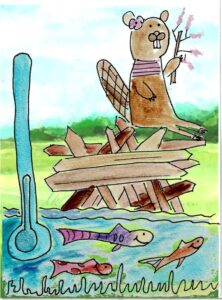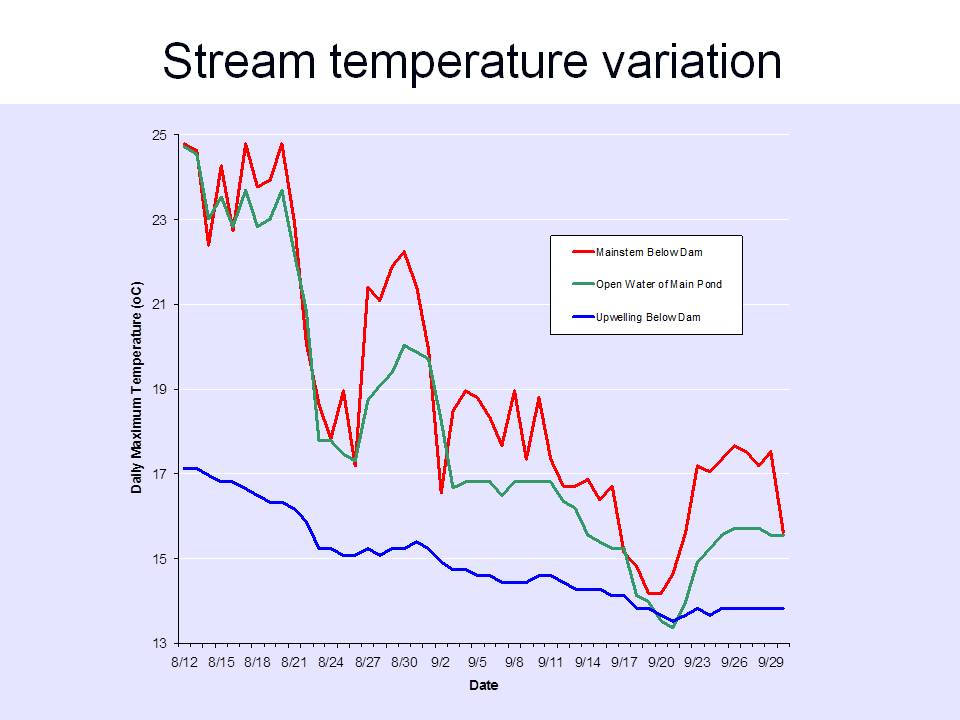Guess what else beavers can do? Cool the water for fish. Uhhh really? You mean the opposite of what people expect? Once upon a time, a very very long time ago Moses sent me footage of sacramento suckers resting in the beaver dam. And because I had been trained to send species information to interested parties I forwarded it to some creek people.
They surprised me by not saying “Wow great the pond has suckers” but by saying “look how hot that water is making the fish lazy.” “The beaver dam has raised the temperature, they do that.”
Mind you they never actually took the temperature of the water or asked for more footage of the fish after they paused. They just assumed it was hotter because that’s what their professor’s said or they had heard before or assumed. They believed it so hard they even SAW EVIDENCE in a slanted way as proof of their theory,.=
And you know what? Those fish were fine.
River heat waves are temperature extremes that last several days or more. “They’re out of the ordinary—often 5 to 10 °C warmer than normal for the time of year and place,” says Jonathan Walter, a UC Davis quantitative ecologist who co-authored the 2022 nationwide study. Warm water can stress or even kill aquatic life. Fish that depend on cold water, such as salmon, steelhead and cutthroat trout, are particularly at risk.
BEAVER DAMS
Other ways to cool rivers and streams include restoring riparian forests, which shade waterways from the sun, as well as floodplains, which connect surface flows with those underground. “Water spreads out and a lot of it seeps into the ground,” Null says. “Then it flows under the surface and wells back up to the river, cooling it in the summer.” Beyond depths of about three feet, ground temperatures are relatively low year-round.
Likewise, beavers can bring stream temperatures down: their dams create ponds that allow water to sink into the cool ground, says Benjamin Dittbrenner, a Northeastern University ecologist who studied the impact of relocated beavers on mountain stream temperatures in Washington state.
 Dittbrenner led a 2022 study showing that large beaver complexes, which have five to 10 dams, lowered stream temperatures as much as 6 °C at one of the complexes studied and an average of 2.4 °C across all them. “That’s huge—2.4 °C doesn’t sound like much but it’s really awesome for fish,” he says. Water temperatures above 17 °C can impair coho salmon, for example hindering their ability to hunt, and temperatures above 23 °C can kill them.
Dittbrenner led a 2022 study showing that large beaver complexes, which have five to 10 dams, lowered stream temperatures as much as 6 °C at one of the complexes studied and an average of 2.4 °C across all them. “That’s huge—2.4 °C doesn’t sound like much but it’s really awesome for fish,” he says. Water temperatures above 17 °C can impair coho salmon, for example hindering their ability to hunt, and temperatures above 23 °C can kill them.
Michael Pollock once told me that some of the older hallowed studies saying that beaver dams raised stream temperatures were based on floating thermometers that only measured the top inch or two of water in the pond. It’s a different story down at the bottom of the pond.

Comparing stream temperatures before and after beaver relocation showed that large beaver complexes kept the water cool enough for salmon. Before beaver relocation, streams were warm enough to impair coho during nearly one-third of the summer. After relocation, water temperatures never reached that threshold “even though it was a really hot summer,” Dittbrenner says.
The prevailing theory once held that beavers warm streams, and some studies show they can. Dittbrenner thinks it all comes down to the size of the beaver complex and the depth of the ponds. More dams mean more water in the wetlands beavers create, increasing infiltration into the cool ground. And deeper water is cooler at the bottom due to a process called thermal stratification: cold water, which is more dense, sinks while warm water floats on top.
Beaver ponds can offer salmon relief from the heat. “Beaver dams are porous—they’re made of mud and sticks—and fish can squiggle through,” Dittbrenner says. “Deep ponds can be cool at the bottom even when the surface is hot enough to kill fish.”
Let’s just be clear. People ASSUME beavers are bad news for fish. Even though on some level they must realize that we used to have more fish AND more beavers.
Understanding river heat waves in California and elsewhere will help identify waterways where temperatures rise high enough to threaten aquatic life. This in turn will help set priorities for protections that cool water, boosting the climate resilience of salmon and other imperiled species that increasingly rely on cold water refuges to escape the heat.
It’s time to admit that your assumptions are WRONG. Beavers are good news for streams. Good news for fish. Good news for generally all species. Just face it.







































